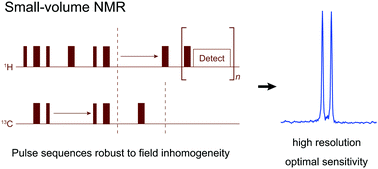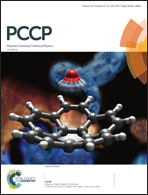Toward high-resolution NMR spectroscopy of microscopic liquid samples†
Abstract
A longstanding limitation of high-resolution NMR spectroscopy is the requirement for samples to have macroscopic dimensions. Commercial probes, for example, are designed for volumes of at least 5 μL, in spite of decades of work directed toward the goal of miniaturization. Progress in miniaturizing inductive detectors has been limited by a perceived need to meet two technical requirements: (1) minimal separation between the sample and the detector, which is essential for sensitivity, and (2) near-perfect magnetic-field homogeneity at the sample, which is typically needed for spectral resolution. The first of these requirements is real, but the second can be relaxed, as we demonstrate here. By using pulse sequences that yield high-resolution spectra in an inhomogeneous field, we eliminate the need for near-perfect field homogeneity and the accompanying requirement for susceptibility matching of microfabricated detector components. With this requirement removed, typical imperfections in microfabricated components can be tolerated, and detector dimensions can be matched to those of the sample, even for samples of volume ≪5 μL. Pulse sequences that are robust to field inhomogeneity thus enable small-volume detection with optimal sensitivity. We illustrate the potential of this approach to miniaturization by presenting spectra acquired with a flat-wire detector that can easily be scaled to subnanoliter volumes. In particular, we report high-resolution NMR spectroscopy of an alanine sample of volume 500 pL.

- This article is part of the themed collection: 2017 PCCP HOT Articles


 Please wait while we load your content...
Please wait while we load your content...